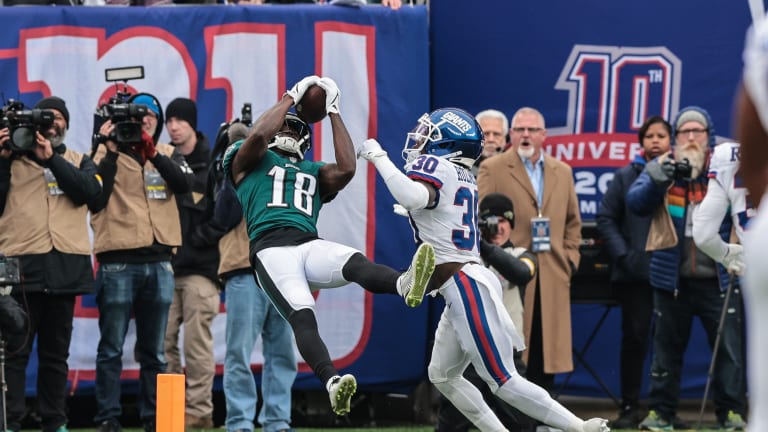
The Vikings get depth, punt returning and a flier in Jalen Reagor

First round picks get second chances.
On Wednesday the Minnesota Vikings traded a 2023 seventh-round selection and 2024 conditional fourth-round draft pick for Philadelphia Eagles receiver Jalen Reagor, whose current claim to fame is being taken one spot ahead of Vikings superstar Justin Jefferson in the 2020 NFL Draft. Over his two-year career, Reagor has totaled 64 catches for 695 yards and three touchdowns. Additionally he’s returned 35 punts at 9.2 yards per return and one score.
With No. 4 receiver Bisi Johnson tearing his ACL in the final preseason game, the Vikings needed someone with experience to provide depth behind their starting trio. Clearly they did not believe in second-year receiver Ihmir Smith-Marsette because he was released to make room for Reagor.
In the short term, Reagor provides somewhat of a parachute in case Jefferson, Adam Thielen or KJ Osborn gets banged up. Last year the Vikings’ passing game sputtered when Thielen was lost to an ankle injury, in part because they didn’t have anyone with experience coming off the bench and the Vikings were forced to move Osborn to outside receiver more often. Osborn produced the NFL’s highest QB rating when targeted out of the slot, per PFF, but only grabbed 19 of 36 passes for 280 yards on the outside. Should there be a similar injury this year, Reagor has played both inside and outside, with 20% of his snaps coming from the slot, so he could ideally fill in wherever the team needed in an unfortunate scenario.
When the receiver room is healthy, Reagor will likely be returning punts. During training camp and the preseason the Vikings struggled to find a punt returner. They gave Smith-Marsette ample opportunity but his returns were too often adventurous. Reagor, on the other hand, was PFF’s second highest graded punt returner last season (with at least 15 returns).
So expectations for Reagor in Minnesota should be tempered. If he mixes in occasionally, holds the fort down during a short-term injury and does a solid job returning punts, then the Vikings will have gotten what they were looking for.
But any time a former first-round pick is traded, there’s a feeling that they may have landed something more because once upon a time he was considered an elite talent. And teams often line up for ex-first rounders with hopes that the player just needed a change of scenery to maximize their skill. Since 2018 we have seen failed first-round picks routinely traded, from Hayden Hurst to Mike Hughes to Billy Price to N’Keal Harry to CJ Henderson. Seemingly regardless of poor performance or injury issue, there’s always a buyer.
Most of those deals didn’t work out for the acquiring team. The Falcons let Hurst walk in free agency after a 26-catch 2021 season. Price was the fourth lowest graded pass blocker. Harry suffered a serious ankle injury in Bears camp. Henderson gave up a 130.1 rating into his coverage. Hughes played a useful role in Kansas City's 2022 secondary, playing 509 snaps and producing a strong 78.8 PFF coverage grade.
The recent history of first-round receivers who did not take off in their first two years is not promising to the Vikings’ chances of discovering a gem. Going back to 2015, here’s the list of receivers who did not thrive right away with their drafting team: Kevin White, Breshad Perriman, Phillip Dorsett, Corey Coleman, Josh Doctson, Laquon Treadwell, John Ross and N’Keal Harry. Several of them contributed in other places but no major upsides were ever reached.
To quote Tobias Funke from Arrested Development: “But it might work for us.”
If there is a case to be made for Reagor reinventing himself in Minnesota, it starts with the circumstances in Philadelphia. He was on the other end of suspect QB play and went through a coaching change in his second year. The Eagles tried using him as a deep threat and that didn’t stick as the former TCU standout caught only four of 25 passes beyond 20 yards in two years. They tried him on quick passes, which was only mildly effective (6.4 yards per catch on throws behind the line of scrimmage) and gave him 14 carries that resulted in only 58 yards.
If there is a flicker in Reagor’s stat sheet, it’s in the intermediate passing game. On throws between 10-19 yards, he grabbed 16 of 29 passes for 222 yards (13.8 yards per catch). In the Vikings’ new offense there might be more opportunities for passes of this nature. PFF graded Reagor highly, scoring him above 89.0 on targets in all three areas (left, middle, right) of the intermediate part of the field.
Of course, that’s slicing the data up pretty good to find a ray of sunshine in an otherwise underwhelming stat sheet. Overall Reagor ranked 89th of 112 starting or situational receivers in 2020 and 104th of 110 in terms of receiving grade last year. For context, he ranked a shade behind veteran Albert Wilson, who the Vikings cut earlier this offseason. Veteran free agent Emmanuel Sanders finished almost 50 spots higher. Those numbers point more toward asking if he was worth giving up any assets rather than whether he could become a quality role player this year with future potential.
But Reagor hasn’t yet turned 24. He can definitely contribute as a punt returner and the rest will work itself out. The odds may be low of him ever escaping the shadow as the guy picked ahead of Jefferson but any contribution on special teams or from a depth receiver spot will be a plus.







